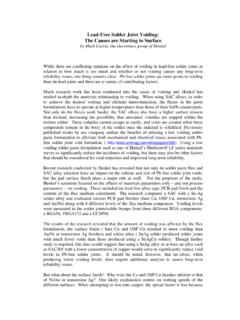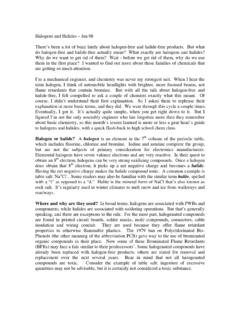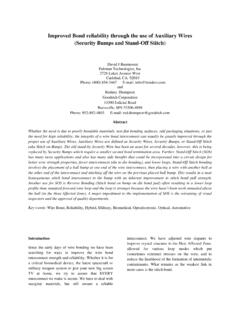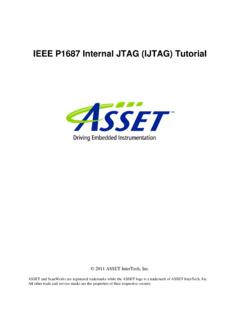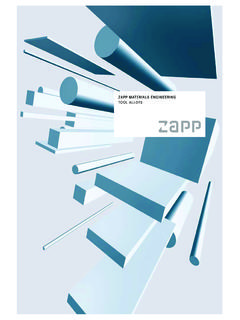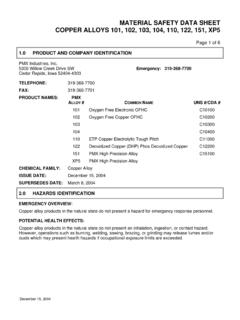Transcription of Indium-Lead Solder Alloys for Reliable Gold …
1 Indium Corporation Tech PaperFrom One Engineer To Another 1 Authored by: Maria Download article Share with a friendA QR (quick response) code contains encoded data. When scanned with a smart phone s camera (via a QR reader application), it will take you to a specific URL or text No. 9 8 852 R0 Indium-Lead (InPb) Solder Alloys for Reliable Gold Interconnects in Assembly ProcessesMARIA DURHAMM aria Durham, is a Product Specialist for Indium Corporation s Semiconductor and Advanced Assembly Materials group. Maria is responsible for interfacing with equipment partners and serving as a technical liaison between customers and internal departments, including sales, technical support, R&D, and operations to perform experiments, gather data, and author technical : biography: (Au) interconnections are used in many electronics assembly processes because the surface of gold does not change over time, unlike most other metals: even silver is subject to oxidation and tarnishing.
2 Gold as a solderable surface (metallization) is often used in the form of a thin film of immersion gold on electrolessly-plated nickel (AuNi), also called ENIG , which is often used as a metallization to be soldered by standard Pb-free or tin-silver-copper (SnAgCu, SAC ) Solder Alloys . During reflow, the thin gold layer rapidly dissolves into molten tin (Sn) based solders, allowing the Solder to wet onto the underlying pristine nickel surface and form a nickel-tin intermetallic. The gold dissolves into the tin to form an AuSn intermetallic.
3 However, when the gold concentration becomes too high, the intermetallic appears as large crystals in the bulk Solder and can have a significant, deleterious, effect on the thermal fatigue characteristics of the interconnection. Some applications call for gold metallizations where the need for reliability is high but Pb-free or SAC Alloys are not acceptable. These may be applications where:1. Gold is required to be used at thicknesses that will generate significant levels of gold-tin intermetallic.
4 Often, the quoted desirable upper limit is 4% by weight, but levels as low as may reduce the lifetime of the joint [1].2. The metal layer underlying the gold is not solderable, and therefore may not be wet by the Solder after the gold is dissolved: one example is Multiple reflow cycles (perhaps 5 or more) may be used after the initial soldering to the gold surface. This may be in conjunction with either 1 or 2. In either situation, the brittle tin-nickel intermetallic is formed, and may be found to grow unacceptably (InPb) Alloys can be used to Solder to precious metal surfaces, including gold.
5 Unlike a Pb-free or SAC alloy, gold is much less soluble in lead, and lead also dissolves gold at a much slower rate than tin, making it resistant to embrittlement. For example, it has been noted that even at 250 C, 50In/50Pb dissolves gold at a rate 13 times slower than 63Sn/37Pb [2]. Common Indium-Lead AlloysBased on the perceived environmental risks associated with lead toxicity, the use of lead in solders is restricted in some instances, therefore, compliance with well-known mandates such as RoHS or Indium Corporation Tech PaperFrom One Engineer To Another 2 RoHS2 is necessary [3].
6 However, there are currently many high-reliability applications, such as those mentioned in the European ELV legislation [4], where lead is allowed in automotive applications, such as where Alloys with greater than 85%Pb admit no substitute. Table 1 shows the most common InPb Alloys and their properties. Table 1 is sorted by liquidus temperature (the temperature at which the Solder is completely liquid); note that eutectic materials have a single melting point. Three common comparison materials are highlighted in blue. In addition to the wide selection of melting points, indium-containing Alloys have comparable thermal and electrical conductivity to standard Solder most commonly used Indium-Lead alloy is Indalloy 205 (60In/40Pb), as it has the closest liquidus temperature to the tin-lead eutectic (183 C), Indalloy 106.
7 Therefore, it is a near drop-in for this tin-lead alloy and can be reflowed using a standard tin-lead eutectic profile. Indium-Lead also has a similar mechanical strength and coefficient of thermal expansion (CTE) to that of the tin-lead eutectic. The next commonly used Alloys are Indalloy 7, 204, and 206. Advantage of Indium-Lead AlloysThe much higher-melting Indalloy 164 ( ) has the lowest coefficient of thermal expansion of all the Indium-Lead Alloys . It is able to withstand the higher temperature excursions that are seen in power electronics, where Solder is often used as a die-attach in Solder paste or wire form.
8 The high melting point helps the Solder withstand the operational temperatures associated with engine compartment electronics [2], such as in applications where Indalloy 151 ( ) is commonly used. Another advantage of using Indium-Lead Alloys is their malleability. They exhibit high resistance to fatigue-cracking when thermal cycling from -55 C to 125 C. When compared to tin-lead Solder joints, 50In/50Pb Solder joint fatigue life is about 100 times greater [2]. Indium-Lead Solder is the best to use on very rigid structures such as ceramic-to-metal or ceramic-to-ceramic.
9 For step-soldering type applications, an alloy such as 81Pb/19In (Indalloy 150) may be used, as its melting point range places it between standard high-melting high-Pb Solder such as Indalloy 151 or 163 ( ) and lower melting solders such as the tin-lead eutectic. To fine-tune the properties required by the customer [3], the desired temperature range of the step-soldering alloy can be adjusted as needed by changing the indium-to-lead ratios. Indium Corporation can work with you on this to make Solder to fit a specific contribution of InPb Solder Alloys is understated but significant in modern electronics, especially in applications where the need for high reliability exists, but where Pb-free or SAC Alloys are not acceptable.
10 Table 1. Indium-Lead (InPb) alloy combinations and ConductivityThermal Conductivity @ 85 CCTE @ 20 CTensile StrengthShear StrengthShear ModulusElongationIndalloy #Liquidus CSolidus CElemental Composition (% by Mass)% of IACSW/c m - CPPM/ CPSIPSIPSI x 106% to Corporation Tech PaperFrom One Engineer To Another 3 Other Common Indium AlloysCommonly used Pb-free indium Alloys include pure indium, indium-tin, and indium-silver. Pure indium metal (available from Indium Corporation in purities up to ) is frequently used for its unique ability to bond to ceramic materials and glass [5] in air at room temperature.
